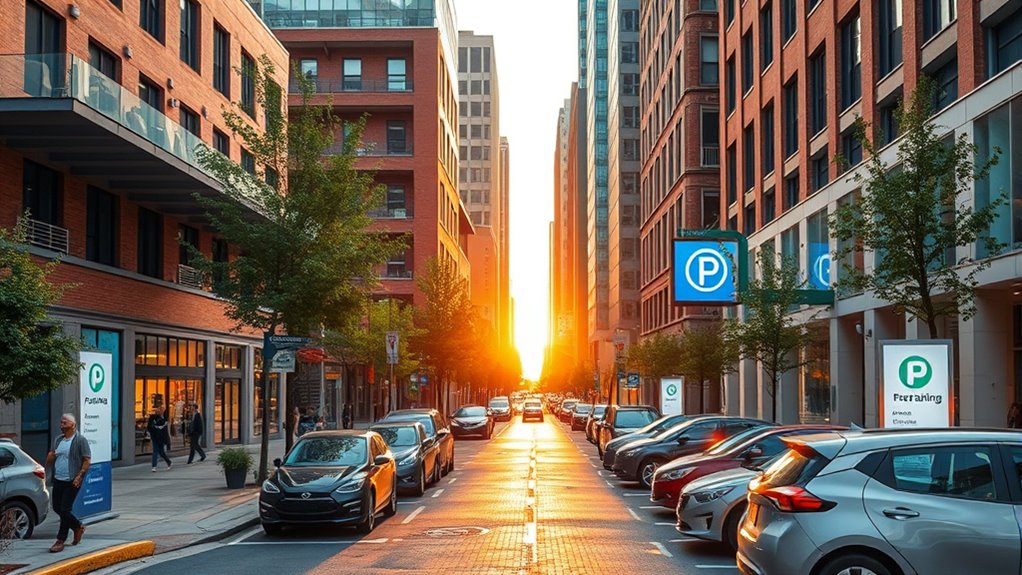Implementing free parking in urban centers can boost local business and improve access, but it also leads to traffic congestion, inefficient land use, and pollution. To balance these effects, consider time-limited and zone-based policies, which promote turnover and reduce overflow. Enhancing infrastructure with smart sensors, encouraging alternative transportation, and involving community stakeholders help create a sustainable parking strategy. If you want to discover effective approaches, keep exploring these smart solutions.
Key Takeaways
- Implement designated free parking zones with clear signage to control usage and prevent congestion.
- Combine free parking with incentives for public transit, biking, and walking to reduce overall parking demand.
- Use real-time parking sensors and mobile apps for efficient management and to inform users about available spots.
- Establish time limits and zone-based policies to promote turnover and optimize parking space utilization.
- Engage community stakeholders to develop balanced strategies that support local businesses and urban mobility goals.
Assessing the Impact of Free Parking on Urban Mobility
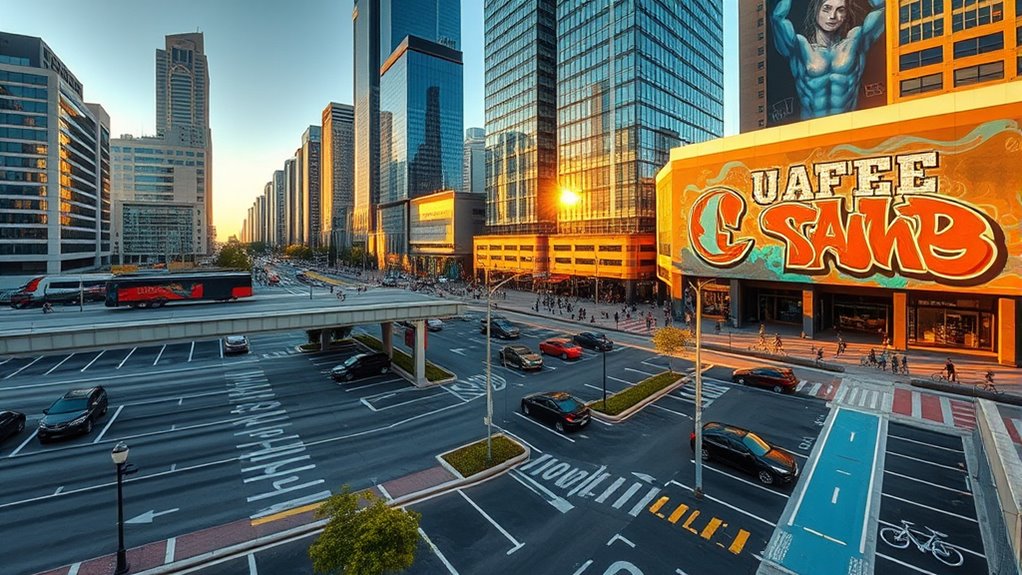
Free parking in urban centers often influences how people choose to travel, but its overall impact on mobility can be complex. When parking is free, you might notice increased parking congestion, as more drivers circle streets searching for available spots, which adds to traffic delays. This congestion can hinder efficient movement through the city and discourage alternative transportation modes. Economically, free parking can have mixed effects: it may boost local businesses by increasing foot traffic, but it also leads to higher urban congestion costs and infrastructure strain. These factors can reduce overall mobility and accessibility, making city travel less efficient. Additionally, the presence of free parking can lead to inefficient land use, as valuable urban space is dedicated to parking rather than other development. Recognizing the behavioral patterns associated with free parking helps urban planners address congestion issues more effectively. Understanding these dynamics helps you see how free parking policies shape urban transportation patterns and their broader economic implications.
Leveraging Technology for Smart Parking Management
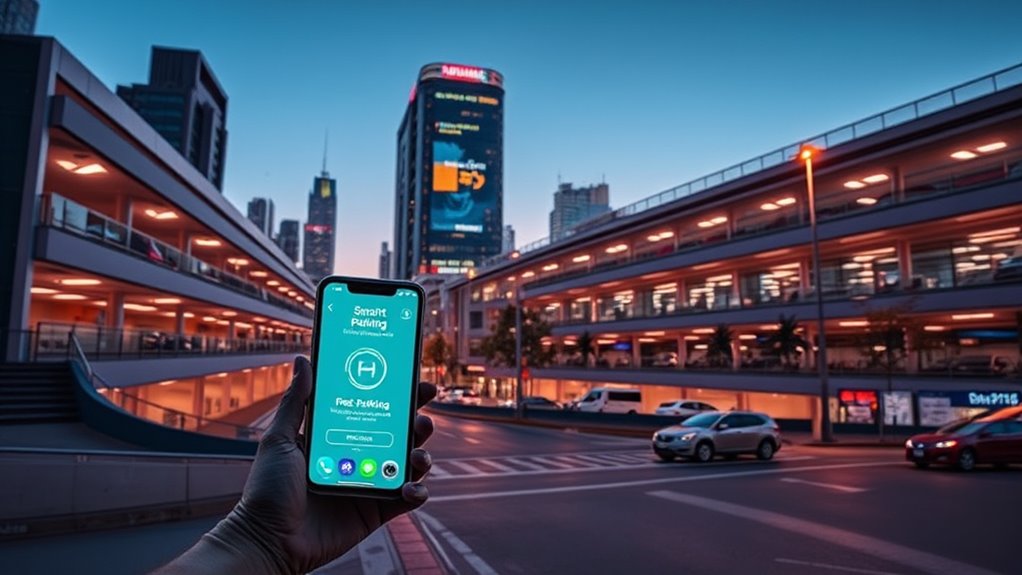
Leveraging technology has transformed parking management in urban centers, making it more efficient and user-friendly. Parking sensors now provide real-time data on available spots, reducing the time you spend searching for parking. These sensors communicate with centralized systems, helping city officials monitor occupancy and optimize space usage. Parking sensors also enable dynamic pricing and time limits based on demand, encouraging better space utilization. Mobile apps further enhance your experience by offering instant access to parking availability, navigation, and even reservation options. With these apps, you can quickly find free or affordable parking spots, saving you time and reducing congestion. The integration of parking sensors and mobile apps allows for smarter, more responsive parking systems that adapt to demand. Regular updates and maintenance of sensor technology ensure continued accuracy and reliability of parking data, which is essential for maintaining system efficiency and user trust. Additionally, incorporating air quality monitoring can help cities ensure that parking areas remain healthy environments for users. Implementing real-time data analysis can further optimize parking operations and reduce environmental impact by adjusting management strategies dynamically.
Implementing Time-Limited and Zone-Based Parking Policies

Implementing time-limited and zone-based parking policies can considerably improve urban parking efficiency by directing vehicle turnover and reducing congestion. These policies help guarantee that parking spaces are available for short-term use, making parking subsidies more effective for visitors and local businesses. By setting clear time limits within designated zones, you encourage drivers to move their cars, which reduces long-term parking and eases congestion. Effective parking enforcement is vital to uphold these policies, deterring violations and ensuring compliance. Proper signage and consistent enforcement foster fairness and maximize the benefits of zone-based systems. When applied correctly, these strategies create a more dynamic parking environment, improve turnover, and support a healthier flow of traffic in busy urban centers. Parking management is essential for maintaining an efficient urban transportation network. Additionally, understanding the contrast ratio of parking zones can help optimize the visual clarity of signage and markings, making compliance easier for drivers. Incorporating clear zoning boundaries and consistent enforcement practices further enhances the effectiveness of these policies, ensuring that the intended benefits are achieved. Implementing effective signage can also significantly influence driver compliance and overall policy success. Moreover, integrating space utilization techniques can help maximize the efficiency of available parking areas and reduce the need for additional infrastructure.
Promoting Alternative Transportation Options
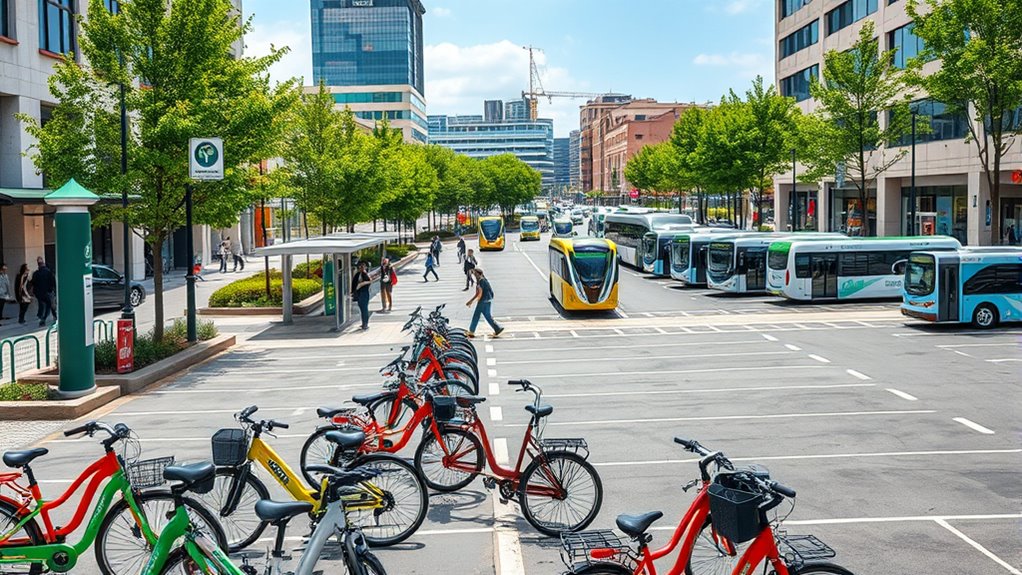
Encouraging the use of alternative transportation options can considerably reduce reliance on personal vehicles, easing congestion and decreasing environmental impacts in urban centers. You can promote this shift through parking incentives that reward those who choose biking, walking, or public transit. Offering commuter subsidies makes alternative options more affordable, motivating more people to leave their cars at home. These strategies not only reduce the demand for parking but also help lower emissions and improve air quality. By making sustainable transportation more attractive and financially accessible, you support a healthier, more efficient city environment. Implementing these initiatives demonstrates your commitment to reducing traffic congestion while providing practical benefits for commuters seeking greener travel choices.
Engaging Community Stakeholders in Parking Policy Development
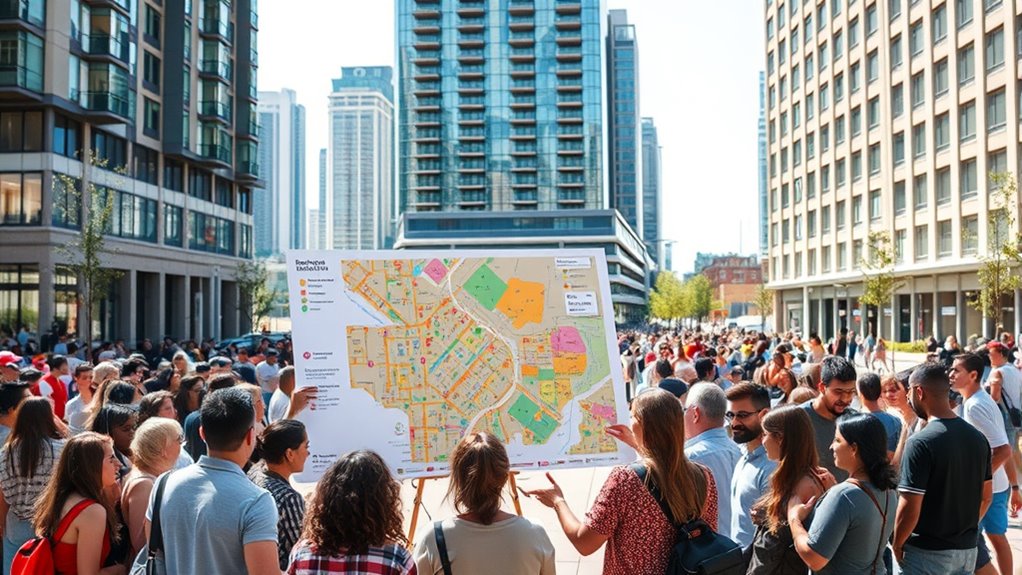
Engaging community stakeholders in parking policy development is essential for creating solutions that meet local needs and enjoy broad support. Your active participation guarantees that diverse perspectives are considered during policy formulation, leading to more effective and accepted strategies. By involving residents, business owners, and local organizations, you foster community engagement that builds trust and transparency. This collaborative approach helps identify specific parking challenges and opportunities unique to your area. When stakeholders are part of the decision-making process, they’re more likely to support and comply with new policies. Additionally, understanding Vetted electric bikes options can provide alternative transportation solutions that reduce parking demand and congestion. Recognizing local laws and regulations can further streamline the implementation of these strategies. Staying informed about security zone info can also assist in developing safer parking environments and enforcement practices. Incorporating sound recording techniques into the analysis of parking patterns can improve data accuracy and planning. Furthermore, awareness of cookie management practices ensures that data collection aligns with privacy standards, fostering trust with the community. Ultimately, engaging the community creates more sustainable, practical parking solutions that reflect the real priorities of those affected, leading to more successful and lasting urban parking strategies.
Frequently Asked Questions
How Can Free Parking Influence Local Business Revenue?
Free parking can boost local business revenue by making your area more attractive to visitors. Parking subsidies encourage more people to visit, increasing foot traffic and retail attraction. When parking is free, shoppers are less likely to seek out alternative options, leading to higher sales. You’ll see more customers spending time and money at nearby shops, restaurants, and services, ultimately supporting the growth and resilience of your local economy.
What Are the Environmental Impacts of Free Parking Policies?
You might wonder about free parking policies’ environmental impacts. They can increase urban heat by encouraging more cars, which raises temperatures and contributes to pollution. However, offering free parking may reduce pollution from search traffic, as drivers spend less time circling for spots. Overall, free parking can both worsen urban heat and help with pollution reduction, highlighting the need for balanced, eco-friendly strategies in urban planning.
How Do Free Parking Strategies Affect Traffic Congestion Levels?
Imagine traffic jams as a never-ending dance, with free parking strategies pulling more dancers onto the floor. Without parking fees, more drivers find it tempting to park nearby, increasing congestion levels. While free parking may seem helpful, it often worsens traffic rather than reduces it. Effective congestion reduction requires thoughtful policies that balance parking availability and discourage unnecessary driving, preventing urban streets from turning into parking lots.
Are There Best Practices for Equitable Parking Access?
You should prioritize parking equity by implementing accessibility initiatives that guarantee all community members have fair access to parking. Focus on inclusive design, such as designated spaces for people with disabilities and affordable options in underserved areas. Engage local residents in planning processes to address their needs. These best practices foster fairness, improve overall accessibility, and help create a more equitable urban environment, making sure that everyone benefits from parking resources.
What Funding Sources Support Free Parking Initiatives?
Think of funding sources for free parking initiatives as the roots that nourish the tree. You can tap into government budgets, grants, and public-private partnerships. Parking subsidies often come from city budgets, while zoning incentives encourage developers to include free parking. These financial supports help sustain free parking programs, making urban centers more accessible and vibrant. By leveraging these sources, you guarantee that free parking remains a thriving part of your city’s landscape.
Conclusion
Balancing free parking with urban mobility isn’t easy — it can ease congestion or fuel it. By embracing smart technology and community input, you can craft policies that serve everyone. Just like a well-designed parking zone, your approach should be flexible yet structured. When you combine innovative strategies with community engagement, you create a city that’s accessible and sustainable. Ultimately, thoughtful parking policies shape a vibrant, connected urban future you’ll be proud to be part of.
